#North Atlantic minke whale
Explore tagged Tumblr posts
Text

North Atlantic minke whale "Balaenoptera" acutorostrata acutorostrata
Observed by pcrosson, CC BY-NC
#Balaenoptera acutorostrata acutorostrata#North Atlantic minke whale#Cetacea#Balaenopteridae#cetacean#whale#North America#United States#Massachusetts#Atlantic Ocean#Gulf of Maine
180 notes
·
View notes
Text

Cryptids & Creatures of Folklore Drawtober Day 14 — Gosse's White-Flippered Whale
In November of 1844, English naturalist Philip Henry Gosse was returning home from an expedition to Jamaica to collect specimens for study when he encountered a pod of at least twelve cetaceans in the North Atlantic Ocean. He and the crew of his vessel would go on to observe these whales for over seventeen hours.
Gosse described the whales as being approximately 30 ft in length, slender, small dorsal fin set far back, a flat head with no pleats on the throat like baleen whales, and black in color except for tan around the mouth and stark white flippers and belly. Now referred to as Gosse's White-Flippered Whales, some theorize that they were an unknown or misidentified species of beaked whale however, Gosse's description sounds more like some sort of minke whale to me—perhaps misidentified, or perhaps an unknown, undiscovered species.
#drawtober#cryptids#cryptozoology#whales#art#cetaceans#gosse's white-flippered whale#white-flippered whale#illustrations
180 notes
·
View notes
Text
The most pervasive representation of whale noises in popular culture are the beautiful songs of humpback whales, which makes sense: they're pretty cool! But there's a whole weird, wonderful world of other whale vocalizations, and here's some of my favorites:
North Atlantic right whales have a call that sounds like a gunshot. It's speculated to be related to reproduction
Minke whales make a bizarre 'boing' noise that baffled navies when it was first heard
Dwarf minke whales make an arguably even weirder noise that has been compared to star wars sound effects
The noises a blue whale, the largest species of whale, makes are below the threshold of human hearing, and need to be sped up in order to be heard at all
And on the opposite end of the spectrum, the noises the smallest species of whale, the vaquita, makes are are above the threshold of human hearing and need to be slowed down to be heard!
Gray whales sound like they're playing the bongos
Ever wondered what rough-toothed dolphins sound like?
Sperm whales communicate with a complex series of clicks that sound like morse code. Each group has their own unique series of clicks called a coda
Wanna hear a narwhal?
North Atlantic right whales greet each other with a vocalization called an upcall, which sounds like a slide whistle going up!
Bowhead whale songs are compared to jazz. I'm not sure I hear it, but it's definitely cool
And finally, I found this while I was looking for videos of these sounds. Please enjoy (?)
39 notes
·
View notes
Photo
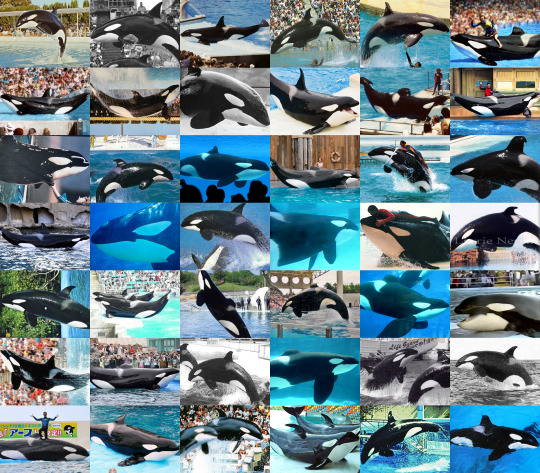
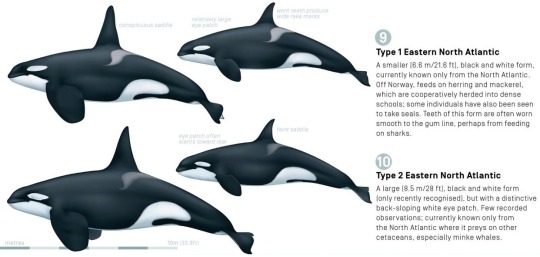
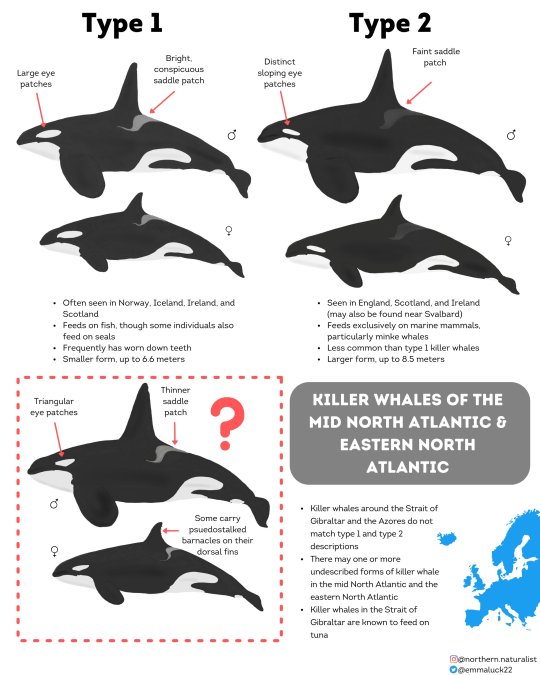
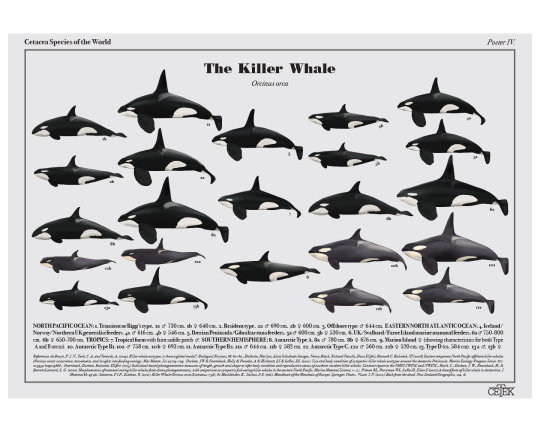

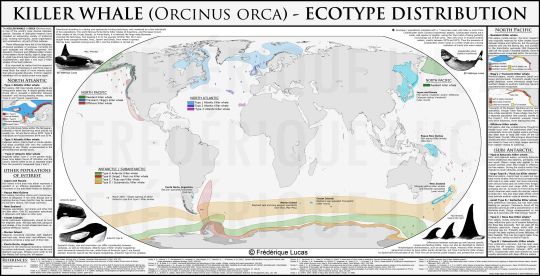
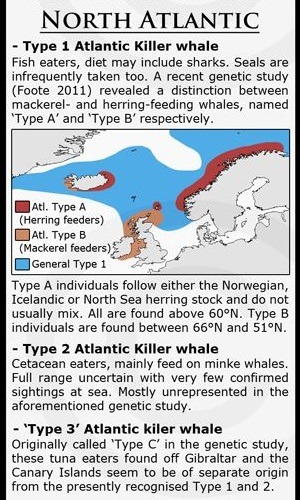
Icelandic whales and ecotype
I’ve seen some claims going around that the Icelandic whales displayed in zoos and aquariums for the past several decades are actually two different ecotypes, with some being “North Atlantic type 1″ and a few others being “North Atlantic type 2″.
I think this is completely wrong, and will show you why.
Above are an assortment of ecotype infographics.
As you can see, “type 1″ are the typical whale you’ll find off Iceland and Norway. They eat mainly herring and other small fish (though some individuals have been observed taking seals), and males typically range from 6.2-6.6 meters, females, around 5.5 meters.
They have clear saddlepatches, and tend to have eyepatches like this:

As the closeup of the map image (last image in the collection above) shows, “type 1″ orcas are also in turn split into type A and B. Type “1A”, if you will, follow exactly the range of where Icelandic whales were caught, and along the Norwegian coast (this eyepatch collage is of both Icelandic and Norwegian whales).
As all the other ecotype infographics show, “type 1″ live off Iceland, Norway, with a couple pointing out that they may range as far south as Scotland and Ireland.
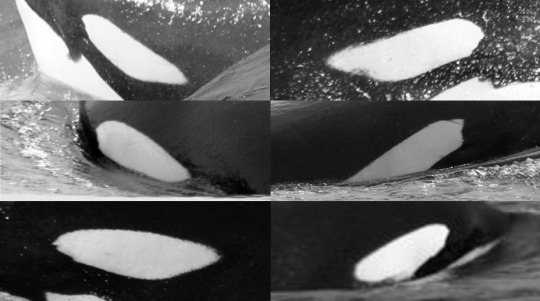
“Type 2″ on the other hand, is huge, one of the largest killer whales anywhere on Earth (after Antarctic type A). Males are 7.5-8.5 meters long, females 6.5-7 meters. They have distinctive downwards sloping eyepatches (like sad eyebrows, seen above), faint saddlepatches, are are very rarely seen, range around Britain, Ireland, the Faroes, and occasionally as far as Svalbard - not Iceland or Norway. They are mammal-eaters, specializing in minke whales as prey. Today, only a few of them remain.
The claim is then, that some of our Icelanders in human care are secretly, actually, type 2.
Let’s look at them. I have gathered all the whales caught in Iceland into a large collage, here split for ease of viewing. The only named whales I couldn’t get good enough images of were Canuck 2, Magnus and Benkei 2.
If the whale is still alive or died as an adult, I will provide measurements, if known.
I originally wrote descriptions for all the following whales, but it got tiring, repetitive, and too lengthy.

Kim, Gudrun, Kenau, Kandu 5, Hoi Wai, Kona 2, Winnie, Betty, Kahana, and Kasatka.
All of very typical “type 1″ looks.
Kim
Gudrun has no measurements available, but as can be seen when she lived at SeaWorld as a full-grown female, she was not large.
Kenau was caught with Gudrun. She was 5.5 meters long when she died at age 16.
Kandu 5. Interestingly, Orkid is the only whale in human care who has anything like the type 2 eyepatch, but she’s the daughter of Kandu who does not, and a Northern resident (Canadian) father who also did not. Kandu measured under 5.4 meters when she died.
Hoi Wai
Kona 2 was likely caught with Kandu 5, had enormous, distinct eyepatches, and she was 5.5 meters long at the time of death.
Winnie was caught with Hoi Wai as said, had a typical Icelandic eyepatch, and the same size and shape as other Icelandic females she lived with.
Betty was caught along with Katina, so they were likely pod mates.
Kahana was caught with Kasatka. She was particularly petite, measuring barely 5.1 meters when she died aged 15.
Kasatka was a mere 5.2 meters long, and looks nothing like a type 2 whale.

Shawn
Kotar was 17-18 years old when he died, and measured 6.4 meters at the time of his death.
Katina is a typical, squat and stocky Icelandic whale with large eyepatches. She is just barely 5.5 meters long.
Dzul-ha
Caren was just 10-11 years old when she died, and measured 5 meters long.
Kiska was a larger female at 6 meters. Large for a type 1, but nowhere near the 6.5-7 meter type 2 females.
Keiko was an average-sized type 1 male at about 6.4 meters.
King
Ulises is another average-sized type 1 male, at 6.4 meters.
Bjossa is another I can find no measurements of, but she was much smaller than Corky, who is 6.1 meters (a Northern resident). She looks typical of an Icelandic whale if a bit long. Looking at the top middle whale of my eyepatch collage, that whale looks just like Bjossa.

Finna was caught along with Ulises, Bjossa and Vigga, his pod mates.
Vigga was another stocky and short female with large eyepatches, notably smaller than her 6 meter Northern resident companion.
Nemo
Neptune
Ruka
Noni/Nootka was stocky and large female, at 6 meters, but with a bright saddle and eyepatches so commonly seen among Icelandic and Norwegian herring-eaters.
Freya was the only adult I could find who had a truly faint saddle patch (note that juveniles of all ecotypes tend to have faint saddles). She was also very long and slender compared to the typical, more stocky Icelandic female. She was however caught along with Kim 2 and Haida 2, and measured 6 meters in her late 20s. Her eyepatch is not type 2.
Haida 2 was, unlike her likely pod mate Freya, very typical in appearance for a type 1. She measured 5.2 meters at the age of 13.
Kim 2 was reportedly a large male, at 6.9 meters, just under Tilikum in size.
Nootka 4 (strange designation since she was caught one year after “Nootka 5″) was the same size as Haida.

Tilikum was the largest Icelandic killer whale in human care, reportedly at just under 7 meters, though I have also seen 6.7 meters (in 2016, shortly before his death). Even if he was 6.9 meters, that is indeed large for a type 1, but absolutely minute for a type 2, and he looks nothing like them.
Nandu
Samoa was 5.15 meters long when she died, with a clear type 1 eyepatch and saddle patch.
Junior
Bingo had interesting triangular eyepatches and a black line in his saddle, and measured 6.5 meters in his early 30s.
Patty
Kandu 7
Prince
Maggie
Oscar was an unusually small male, measuring only 5.8 meters at the age of 26.

Stella is very small, only around 5.2 meters long.
Ai
Ran
Sharkane
Tanouk measured 6.4 meters in his teens (meaning he would grow larger for a few years).
So that’s all of them, except for Canuck 2, Magnus, and Benkei 2.
Then, there is this:
You can stop calling North Atlantic killer whales type 1 and type 2
“The main issue with type 2 killer whales came from the small sample size (5 individuals)”
“In the meantime, Dr. Foote suggested we just drop the “type 1/type 2” classification for now.”
There is simply no basis to think any of the above 45 whales from Iceland are or were the “type 2″ whales, like John Coe.
57 notes
·
View notes
Text
Monofin Shape
Since the current monofin I have is unfortunately not suitable for me due to the shape of my feet. I will have to create a new one, this is something I did plan to do eventually though it was not my expectation to do it so soon.
Using OpenRocket I have created a rough design. This program does not well calculate stability in non axisymmetric systems so I have used three fins in this example in both the flippers and flukes, though obviously in a suit version this would not be the case.

In such a design the total suit would be roughly 3000 millimeters in length with my arms in the flippers (the forward fins). My width currently is roughly 380mm, though this may evolve as my body does, which stays fairly constant to my thighs narrowing to around 280mm at the ankles. Also due to the thickness of my arms, the base of my flippers will likely have to be around 120mm thick.


This does conform fairly closely to the shape of a minke body. In this example my flippers are a bit too long, flukes a bit too big. These could probably be explained some amount by genetic variation or something. Though it should be noted that this whale I am comparing against is a dwarf minke whale, and not a common minke whale, which I believe is still the same species but a different subspecies. Unfortunately great pictures of north atlantic common minke whales seem to not be available outside of breaching pictures. The main difference in the planforms between my rough approximation is that the tail would not narrow at a quite enough rate.
In addition this, human bodies are broad and flat (though I do at the moment have a substantial stomach, thanks antipsychotics), but this will matter particularly in the tail/peduncle. In order to allow sufficient moment to perform a dolphin kick the skin cannot be particularly thick and so in that area will form a generally wide flat area rather than a narrow rather vertical orientation in the peduncle.
How then does this current concept compare with the monofin I currently own. The current monofin is roughly 800mm long and a similar width.

Her size is roughly the same. This current loose model stands roughly 800mm long and roughly 1000mm wide. The shape however is considerably different. The new concept would stand on a peduncle instead of this rough triangle shape.
This will create some differences in behaviour. This monofin due to the thinness throughout the fin flows well and continues the undulating movement, thus making it really quite easy to use. The Dol-Fin is closer to the design I wish to produce. This part does requite much more technique from the hips than the current monofin, but I am a whale and I dont think I really swim with my knees regardless kicking with only my knees really didnt make sense to me when I swim with a monofin. But there is a notable difference between my concept and the Dol-Fin, namely that mine will sit on a peduncle rather than being directly attached. Provided then the peduncle has sufficient flexibility it should continue my movements as I swim essentially extending the dolphin kick wave of my body.
How to actually construct and design the fin will be the next topic of discussion. I will probably write on that either later tonight or tomorrow.
14 notes
·
View notes
Text
Whale Tournament Masterpost!
Welcome to the whale swag bracket, a competition to determine the best species of whale! This competition will include 64 species (who have already been selected) in the infraorder Cetacea, which includes whales, dolphins, and porpoises.
All match ups were decided randomly, and I did my best to prevent any ridiculously unfair matchups. I encourage everyone to make an effort to learn about some lesser-known competitors, I’m sure you’ll find them quite interesting!
The only rules are to have fun, be nice to everyone, and don’t bot the polls please I love whales too but let’s make this fair.
The first round of polls will be split up into two groups to prevent too many polls running at once, and the first round will begin on Friday, February 17th at 12 PM EST. Links to all the polls, as well as the complete bracket, can be found here!
Bracket
Round One, Part One: CLOSED
Gray whale vs True’s beaked whale
Northern bottlenose whale vs Strap-toothed whale
Atlantic spotted dolphin vs Dall’s porpoise
Northern right whale dolphin vs Rice’s whale
White-beaked dolphin vs Cuvier’s beaked whale
Killer whale vs false killer whale
Tucuxi vs Risso’s dolphin
Sei whale vs Narwhal
Heaviside’s dolphin vs Blue whale
Dwarf sperm whale vs Harbor porpoise
Antarctic minke whale vs Hector’s dolphin
Striped dolphin vs Rough-toothed dolphin
Commerson’s dolphin vs Spectacled porpoise
Pygmy right whale vs Sato’s beaked whale
Atlantic white-sided dolphin vs Southern right whale dolphin
Hourglass dolphin vs Common dolphin
Round One, Part Two: CLOSED
Yangtze finless porpoise vs Blainville’s beaked whale
Bottlenose dolphin vs Indus river dolphin
Melon-headed whale vs Southern right whale
Omura’s whale vs Amazon river dolphin
Pygmy sperm whale vs Australian humpback dolphin
Baiji vs Vaquita
Spinner dolphin vs Bowhead whale
Pantropical spotted dolphin vs Dusky dolphin
Australian snubfin dolphin vs Bryde’s whale
Short-finned pilot whale vs Pygmy killer whale
Beluga vs Humpback whale
North Atlantic right whale vs Fin whale
Common minke whale vs Irrawaddy dolphin
Sowerby’s beaked whale vs La Plata river dolphin
Sperm whale vs Indo Pacific humpback dolphin
Baird’s beaked whale vs Pacific white-sided dolphin
Round Two: ONGOING
Gray whale vs Strap-toothed whale
Atlantic spotted dolphin vs Northern right whale dolphin
Cuvier’s beaked whale vs Killer whale
Tucuxi vs Narwhal
Blue whale vs Harbor porpoise
Antarctic minke whale vs Striped dolphin
Commerson’s dolphin vs Sato’s beaked whale
Southern right whale dolphin vs Hourglass dolphin
Yangtze finless porpoise vs Indus River dolphin
Southern right whale vs Amazon river dolphin
Pygmy sperm whale vs Vaquita
Spinner dolphin vs Dusky dolphin
Australian snubfin dolphin vs Pygmy killer whale
Beluga vs Fin whale
Irrawaddy dolphin vs La Plata river dolphin
Sperm whale vs Pacific white-sided dolphin
Round Three: CLOSED
Gray whale vs Atlantic spotted dolphin
Killer whale vs Narwhal
Blue whale vs Striped dolphin
Commerson’s dolphin vs Hourglass dolphin
Yangtze finless porpoise vs Amazon river dolphin
Vaquita vs Spinner dolphin
Australian snubfin dolphin vs Beluga
Irrawaddy dolphin vs Sperm whale
Round Four: CLOSED
Atlantic spotted dolphin vs Narwhal
Blue whale vs Hourglass dolphin
Amazon river dolphin vs Vaquita
Beluga vs Sperm whale
58 notes
·
View notes
Text
Where Can You See Whales in New Brunswick?
Perched along Canada's magnificent east coast, New Brunswick provides some of the most amazing whale viewing opportunities you will find anywhere in the globe. This area has become a refuge for both casual viewers and marine aficionados with its immaculate seas and varied aquatic life. From graceful humpbacks to elusive minke whales, the seas around New Brunswick brim with these ocean giants. Where precisely, though, might you find these amazing animals? Let's explore the greatest places for New Brunswick whale watching and discover the sea's enchantment.
World-Famous Whale Watching Destination: The Bay of Fundy
Regarding East coast whale viewing, the Bay of Fundy is clearly the crown gem of New Brunswick. With the highest tides in the world, this special body of water attracts a great variety of marine species including seals, dolphins, and whales. During the summer and autumn, several whale species find the rich nutrients in the deep waters ideal for eating.
What distinguishes the Bay of Fundy?
The great tidal range of the Bay of Fundy produces an always shifting seascape. The tides draw nutrients from the deep ocean floor when they are strongest, therefore providing a fertile feeding ground for aquatic life. Whales so find the waters of the bay appealing from June to October, which attracts them and makes New Brunswick whale viewing the prime period.
You might come across species including:
Among the most charismatic whale species are humpback whales, noted for their breaching and tail-slapping actions. Often, their light-hearted antics enthral observers.
Comprising the second biggest whale species, fin whales can reach lengths of up to 85 feet. Though little, they are really quick and elegant swimmers.
Though smaller and more secretive, minke whales—known for their shier character—can still be seen in the Bay of Fundy.
Furthermore enhancing the experience are the breathtaking surroundings of the Bay of Fundy. A whale watching tour here seems like entering a postcard with rocks, cavernues, and the majestic Fundy coastline as your backdrop.
Grand Manan Island: A Whale Watching Hidden Gem
Grand Manan Island is also rather amazing for East coast whale viewing. This remote island, which lies near the mouth of the Bay of Fundy, provides a more sedate and personal whale viewing environment. Fewer visitors here make this a perfect place for those looking for a calm but exciting meeting with aquatic life.

Why would one visit Grand Manan Island to view whales?
Deep waters that whales enjoy to visit surround Grand Manan Island. The island's remoteness makes it among the greatest places to see several whale species, including the rare and threatened North Atlantic right whale. Here, Full-Tide Ocean Safaris frequently sets out whale viewing trips giving guests the opportunity to explore these waters under professional guide direction.
The island adds layers of appeal to your whale viewing trip with its charming lighthouses, gorgeous fishing villages, and active local culture. You catch a glimpse of:
One of the most threatened whale species worldwide, spotting a North Atlantic right whale will provide a lifetime of memories. These mild giants grace the seas of Grand Manan during the summer months, with less than 400 left.
Whale Sei: Sei whales are rare and elusive but well-known for their high swimming speed and sleek bodies. Every whale viewing trip gains unique excitement from their sporadic presence around the island.
Peak Whale Watching Times for New Brunswick
In New Brunswick whale watching, timing is important. Although whales can occasionally be seen in the off-season, late June through early October is the busiest months. The whales are most active during this period since they eat in the nutrient-rich Bay of Fundy and environs.
Given whales are more likely to be feeding near the surface, early morning and late afternoon trips usually produce the best results. Also, calm sea conditions during these seasons improve your chances of witnessing these magnificent animals.
Experienced experts who know the waterways and whale behaviours close-by will lead you with Full-Tide Ocean Safaris Our trips seek to maximise your opportunities for observing several whale species while guaranteeing a safe and environmentally responsible experience.
Other Water Life and Adventures Along the East Coast
Although East coast whale watching steals the show, the east coast presents more than simply whales. There is an amazing variety of marine life in the Bay of Fundy and nearby seas. You might run across playful dolphins, porpoises, seals, and even basking sharks. The range of seabirds—including puffins, gannets, and terns—that call the region will also thrill bird aficionados.
Apart from whale viewing, New Brunswick presents lots of activities to improve your nautical experience. The east coast offers something for everyone from kayaking along the craggy coast to investigating tidal pools during low tide.
Your Unique Whale Watching Experience Awaits You
Full-Tide Ocean Safaris provides amazing whale viewing trips catered to your needs whether your search is for a calm, meditative experience or an exciting adventure. We take great satisfaction in providing a first-rate New Brunswick whale viewing experience that takes you closer to nature and the amazing species that call our seas home using the magnificent Bay of Fundy as our playground.
ready to see New Brunswick's whales' grandeur? Plan your trip with Full-Tide Ocean Safaris right now to be ready for an amazing meeting with these ocean monsters!
2 notes
·
View notes
Text
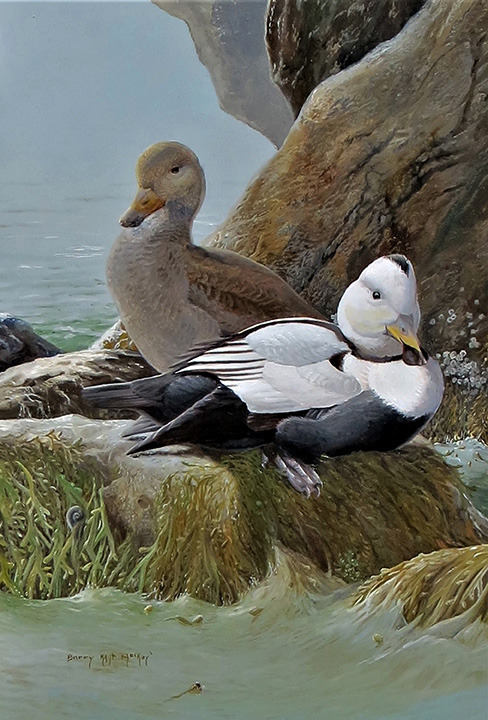
The Labrador Duck (Camptorhynchus labradorius), native to the northeast coast of North America, has been extinct since sometime late in the 19th century, with the last valid sighting being in 1878. Little is known about it, although there are some 55 stuffed specimens of it scattered about the world in various museums. One mystery is the cause of its extinction. All accounts indicate it was already uncommon by the time Europeans arrived in North America, to stay. Its meat was relatively little in demand, due to bad flavor, and reportedly it did not keep well. Certainly such commercial demand that did exist for its meat, feathers, eggs and skins would undoubtedly have been the final cause of its extinction.
But I have a theory. Wherever humans have gone, extinctions occurred. I used to think it would not be possible for the extinction of so many ice-age species in North America to have been caused by the arrival of humans after the last ice age ended. But we now know that humans arrived in the western hemisphere much earlier, perhaps fifteen thousand years ago. We also know that in the absence of humans, many animals, including large ones, simply are not afraid of humans when they arrive.
We can see examples of that, even today, on islands that were historically uninhabited for sure, but even in less frequented continental areas, where foxes or Canada Jays or Boreal Chickadees, to give three examples from my own experience, will act fearlessly in human presence. Urbanites are constantly told not to feed coyotes, or they’ll become used to people and a threat.
The Beothuk people, themselves exterminated, were seal and caribou hunters who once inhabited the area now called Newfoundland and Labrador, thought to be the former breeding grounds of the Labrador Duck (Audubon’s son claimed to have found a nest in Labrador, and probably did.) My theory is that the Labrador Duck was one of a plethora of “ice age fauna” that went extinct as a result of how easily they were killed by humans, having always lived in remote areas. Animals exterminated in North America between the arrival of the first people, and the arrival of Europeans -- horses, elephants, large condors, giant sloths, camels and other species, included ones that were rare when Europeans arrived with their own weaponry. Many that were extirpated or exterminated were from the same region – sea mink, Great Auks, Newfoundland wolves, eastern cougars, eastern elk, Eskimo Curlews (who migrated through the region), even the Atlantic grey whale -- the list is large, and the depletion of native wildlife of the region continues into the present – Canada’s rarest mammal is the northern Atlantic right whale, and of course the collapse of the northwest Atlantic northern cod is recent and well known.
I have researched the species for years, photographed every specimen (and collected photos of every other specimen I could find) and studied renderings of many other artists, most of whom, like me, could only do “best guess” restorations. The painting is about 18 by 24 inches, in oils on a birchwood panel. I am also including a much earlier painting I did of some Labrador Ducks in flight over the Labrador coast at dawn. It was in watercolours on paper.
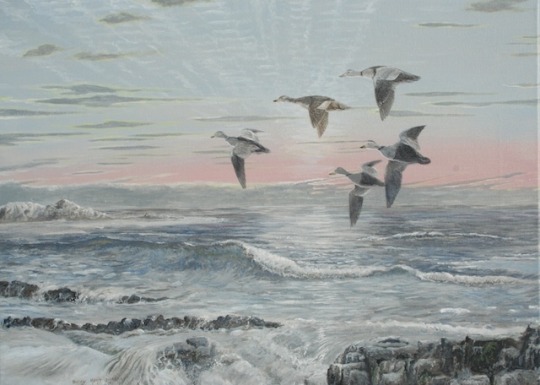
art may be used for non-commercial purposes with attribution
prints and original art for sale on Fine Art America
support barry kent mackay on ko-fi
22 notes
·
View notes
Text
The Ultimate Guide to Isafjordur Whale Watching | An Unforgettable Icelandic Adventure

Why Isafjordur is a Prime Location for Whale Watching
Isafjordur’s unique geographical location makes it a prime spot for whale watching. Located in the heart of the Westfjords, the town is surrounded by deep fjords and rich feeding grounds that attract a variety of whale species. The cold, nutrient-rich waters of the North Atlantic create the perfect environment for these gentle giants to thrive, making Isafjordur one of the best places in Iceland to observe them in their natural habitat.
Unlike other whale watching hotspots in Iceland, Isafjordur offers a more intimate and less crowded experience. The remote and unspoiled nature of the Westfjords means that you can enjoy your whale watching adventure without the large tourist crowds often found in other parts of the country. This allows for a more serene and personal connection with the majestic creatures that call these waters home.
The Whale Species You Can Spot in Isafjordur
One of the most exciting aspects of Isafjordur whale watching is the diversity of whale species you may encounter. The waters around Isafjordur are home to several species, each with its own unique characteristics and behaviors.
Humpback Whales: Known for their acrobatic displays, humpback whales are a favorite among whale watchers. These giants can often be seen breaching, slapping their tails, and performing other spectacular behaviors. Their friendly and curious nature sometimes leads them to approach boats, giving visitors a close-up view of their impressive size.
Minke Whales: Smaller than humpbacks but no less fascinating, minke whales are commonly spotted in the waters around Isafjordur. These whales are known for their sleek bodies and swift movements. Though they are more elusive than other species, they are frequently seen feeding near the surface, making them a common sight on whale watching tours.
Blue Whales: The largest animal on the planet, the blue whale, occasionally graces the waters around Isafjordur. Though sightings are rare, the chance to see a blue whale is one of the most thrilling possibilities for visitors. Seeing the world’s largest creature in the wild is a once-in-a-lifetime experience.
Orcas (Killer Whales): Orcas are known for their distinctive black-and-white coloring and complex social structures. Though more commonly seen in the waters off South Iceland, they do sometimes venture into the fjords around Isafjordur. Their presence adds an extra layer of excitement to any whale watching tour.

What to Expect on a Whale Watching Tour in Isafjordur
Whale watching Isafjordur is an immersive experience that combines the thrill of spotting whales with the stunning beauty of the Westfjords. Tours typically begin at the town’s harbor, where you’ll board a comfortable boat equipped with everything you need for the journey. As you set sail, you’ll be surrounded by breathtaking scenery, including towering cliffs, peaceful fjords, and perhaps even a sighting of seabirds or seals along the way.
The experienced guides on board are an essential part of the tour. They bring a wealth of knowledge about the local marine life, the behavior of the whales, and the ecology of the Westfjords. Their insights help you understand what you’re seeing and deepen your appreciation for the marine environment. They’ll also provide information on the best times and places to spot different species, ensuring you get the most out of your whale watching adventure.
As you venture further into the fjords, the excitement builds. The anticipation of spotting a whale is one of the highlights of the tour. With binoculars in hand and eyes on the water, you’ll be eagerly scanning the horizon for the telltale signs of a whale’s presence: a spout of water, a dorsal fin, or a splash as a whale breaches the surface.
When a whale is spotted, the boat’s captain will carefully maneuver to give everyone the best possible view while maintaining a respectful distance. The moment you see a whale up close is nothing short of magical. Whether it’s a humpback breaching, a minke surfacing, or a pod of dolphins swimming alongside the boat, the experience is one you’ll never forget.
The Best Time for Whale Watching in Isafjordur
Whale watching in Isafjordur is possible year-round, but certain times of the year offer better chances for sightings. The peak whale watching season in Iceland runs from April to October, with the summer months of June, July, and August being the most popular. During this time, the weather is milder, the seas are calmer, and the long daylight hours of the Midnight Sun allow for extended tours.
In the summer, humpback whales are especially active, often breaching and performing other acrobatic displays. This is also the best time to see minke whales and other smaller species. However, even outside of the peak season, it’s still possible to have incredible encounters with these majestic animals. In the winter, the landscape is transformed by snow and ice, creating a magical backdrop for your whale watching adventure.
Tips for a Successful Whale Watching Experience
To make the most of your Isafjordur whale watching experience, here are a few tips:
Dress Warmly: Even in the summer, the weather in the Westfjords can be chilly and unpredictable. Layering is key, and it’s advisable to bring a waterproof jacket, hat, and gloves to stay comfortable on the water.
Bring a Camera: You’ll want to capture the incredible moments on your tour, so be sure to bring a camera with a good zoom lens. If you’re using a smartphone, consider bringing a waterproof case to protect it from the elements.
Listen to Your Guide: The guides on board are experts in whale behavior and local marine life. Listen to their advice on where to look and what to expect, as they’ll help you spot the whales and understand what you’re seeing.
Stay Patient: Whale watching requires patience and a bit of luck. While sightings are common, they can’t be guaranteed. Relax, enjoy the scenery, and remember that part of the thrill is the anticipation.
Respect the Wildlife: It’s important to respect the whales and their environment. The boat will maintain a safe distance from the whales to avoid disturbing them, and it’s crucial to follow the guidelines provided by your guide.

Why Choose Isafjordur for Your Whale Watching Adventure?
Isafjordur stands out as a whale watching destination not just because of the abundant marine life, but also because of the unique experience it offers. The remote location, stunning natural beauty, and knowledgeable guides make Isafjordur whale watching a truly special adventure. Unlike more crowded locations, Isafjordur provides a peaceful and intimate setting where you can connect with nature and appreciate the majesty of the ocean’s giants.
Moreover, the tours in Isafjordur are conducted with a strong sustainability and environmental responsibility. The operators prioritize the well-being of the whales and the preservation of the natural environment, ensuring that future generations can continue to enjoy these incredible experiences.
Conclusion
isafjordur iceland whale watching is a must-do activity for anyone visiting Iceland. Whether you’re drawn by the chance to see humpback whales, curious about the possibility of spotting a blue whale, or simply eager to experience the beauty of the Westfjords, a whale watching tour in Isafjordur will not disappoint. With expert guides, stunning scenery, and the thrill of seeing these magnificent creatures up close, Isafjordur offers an unparalleled whale watching experience. Book your tour today and embark on an adventure that you’ll treasure forever.
0 notes
Text
The Science Is Clear: Offshore Wind Isn’t What’s Killing Whales
Politicians and nonprofit groups have blamed offshore wind turbines for whale deaths, but the science doesn’t support those claims—at all
This claim has been used as a talking point against wind energy by former president Donald Trump, local Republican politicians, nonprofit groups with links to the fossil-fuel industry and more than 50 Fox News segments in 2023. All have connected offshore wind development with horrific images of dead whales washing up and decaying on beaches. At a recent New Jersey campaign rally, Trump vowed to scrap the country’s offshore wind projects on the first day of a new term if he is elected again in November, declaring that “they kill the whales.” But the current scientific consensus doesn’t back up those assertions—at all. There are “no links whatsoever between the offshore wind development activity and especially the humpback whale mortalities. None. Zero,” says Duke University marine scientist Douglas Nowacek.
[...]
That isn’t to say that building huge wind turbines in the ocean doesn’t come without any environmental ramifications. “Even offshore wind proponents such as myself recognize that walking out my front door has an impact, so of course building large-scale machines in the ocean will have an impact,” says Kris Ohleth, executive director of the nonprofit Special Initiative on Offshore Wind. She, Nowacek and other experts say the key task is to understand what the potential harms of turbine surveying and construction actually are and then mitigate them.
So what is killing whales?
Several whale species dwell in and migrate through the North Atlantic, including in waters near the coastal U.S. Though populations of many of these endangered or threatened species have considerably rebounded from the effects of 19th-century whaling, significant threats remain. More than 500 humpback, minke and right whales have been seriously injured, stranded onshore or died prematurely on or near the East Coast since 2017, according to the National Oceanic and Atmospheric Administration. Conducting necropsies on beached whales to pin down a cause of death is made difficult by the animals’ layer of blubber and by the fact that organs can literally cook inside a stranded whale. But it is starkly clear that human activity—in the form of ships that hit whales or fishing gear that wraps around them—is often to blame. “For right whales, if you take out neonatal mortality, every documented mortality in the last 25 years of a right whale has been at the hands of some human cause—ship strike or entanglement,” Nowacek says. “Every single one of them.” The New England Aquarium recently reported that a female North Atlantic right whale known by the name Shelagh had become tangled in fishing gear for the fifth known time.
[...]
Misinformation around this issue perplexes and dismays many whale researchers and conservationists (despite the attention the publicity might bring to a species’ plight) because there are simply no data to back it up. “It’s interesting from my perspective—somebody who’s worked my whole career on whales—to see whales get so much attention in such an odd manner,” Read says. “I like the fact that whales are getting attention, that people are thinking about them and their conservation. I don’t like the fact that people are being told things that are not true.”
1 note
·
View note
Text
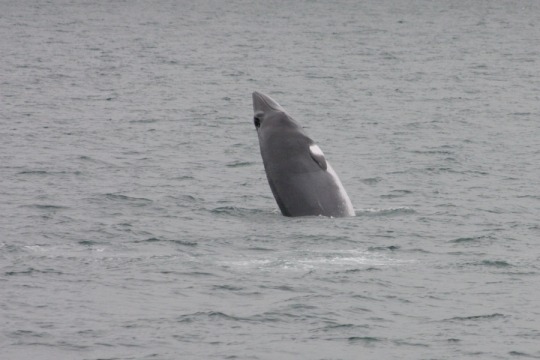
North Atlantic minke whale "Balaenoptera" acutorostrata acutorostrata
Observed by remi_bigonneau
#Balaenoptera acutorostrata acutorostrata#North Atlantic minke whale#Cetacea#Balaenopteridae#cetacean#whale#Europe#Iceland#Atlantic Ocean#Eyjafjördur
11 notes
·
View notes
Text
The sightings included 93 of sei whales, one of the highest concentrations of the rare whale during a single flight, other highlights included two orcas – an uncommon sight off New England – one of which was toting a tuna in its mouth, Noaa said. There were also endangered North Atlantic right whales as well as humpback, fin, minke and sperm whales, the agency said.
0 notes
Text
Day Trips from Reykjavik: Exploring Iceland Beyond the Capital

Introduction
Reykjavik, the capital city of Iceland, is the primary center of attraction for tourists visiting Iceland. But, the real magic of Iceland lies not just in Reykjavik but also in places beyond its capital. It's also about its natural beauty with majestic waterfalls and sensational volcanoes that will take your breath away. So, today we will take a look into places where you can visit while in Iceland beyond its capital city. You can book a taxi service in Reykjavik to visit these places. So, let's dive in.
Golden Circle Tour
The Golden Circle is the most famous of all scenic routes in Iceland and combines stunning landmarks and historically significant places in a circular sightseeing tour. Its proximity to Reykjavík and the airport area, as well as the short drive between the sights, make it convenient for everyone to include the Golden Circle tour into their itinerary. Whether you take only one or more days to explore the Golden Circle, you’ll experience some of the most stunning geological wonders Iceland has to offer!
South Coast Adventure
The south coast of Iceland is an astonishing medley of waterfalls, glaciers, and famous black sand beaches. They are the home to the biggest glacier in Europe and the gateway to some of the most beautiful hiking areas in Iceland. In case you don’t have your own vehicle, a lot of tour providers offer south coast tours starting from Reykjavík, ranging from 12-hour trips to 3-day excursions. We recommend you take your time - there are so many places to enjoy, trails to hike, and sights to photograph!
Snæfellsnes Peninsula Excursion
Snæfellsnes is the long and narrow peninsula sticking out of Iceland into the North-Atlantic Ocean to the west. Snæfellsnesoffers dramatic landscapes and examples of most of the natural wonders found in Iceland and is therefore often called “miniature Iceland” or “Iceland in a nutshell.”
Whale Watching in Faxaflói Bay
Faxaflói is a large bay in west Iceland, between the Reykjanes and Snӕfellsnes Peninsula. It faces Reykjavík and is a hot spot for puffins and whale watching. Throughout the summer, the most commonly seen species are Minke and Humpback whales. Whereas, Harbour Porpoises and White-Beaked Dolphins are seen year-round. Other species are seen on occasion, including Orcas and Blue Whales.
Blue Lagoon Relaxation
The Blue Lagoon is a health and geothermal spa on the Reykjanes Peninsula. A visit to the Blue Lagoon Iceland geothermal spa is an important part of your stay in Iceland. Guests renew their relationship with nature, soak up the scenic beauty, and enjoy breathing the clean, fresh air while relaxing in the warm geothermal seawater.
Conclusion There are many beautiful places to visit in Iceland beyond Reykjavik. Private Tours From Reykjavik are available from many tour websites. Puffin Taxi is one such tour provider where we are dedicated to providing you with the best experience in Iceland that you want. From picking you up at the airport to planning your entire trip to Iceland, we are here to provide you with the best services possible.
#Taxi service in Reykjavik#Taxi in Reykjavik#Private Taxi in Reykjavik#Private Tour#Private Tour from Reykjavik#Puffin Taxi#Private tour opertaor
0 notes
Text
Where the Giants Roam: Exploring the Best Locations for Whale Watching
With giant sea mammals still in the waters, the fascination of observing them in their natural habitat is the major reason why interested people go to the best places for quality whale watching in the whole world. From the grand migrations of whales to the slim profiles of orcas, these locations ensure that one's excitement does not diminish as it offers unforgettable rendezvous with some of the vastness of the sea's animal inhabitants. Among the destinations in this guide, you will pick the best places for a whale watching in Baja, each of them providing an incredible chance to see and remember the spectacle never before.
Baja, California:
Getting to the World’s Greatest Baja whale watching location is so easy to plan. Just call, text or email and we have you covered. From the border crossing into Mexico, to the 2 hour flight to our camp and 45 minute van drive to our remote location one call is all you need to make. Monterey Bay, California: Along the central coast of California, Monterey Bay has earned its fame as "there's no better place to spot whales": it is here. The bay also supports a diverse community of aquatic organisms that thrive in their nutrient-rich water by attracting humpback whales, blue whales, and killer whales among others. Tourists can explore the area by boat tours, or enjoy the spectacular views from the hills such as the Point Lobos State Nature Reserve. Husavik, Iceland: In Husavik, the smallest town in the North of Iceland, whales, which are the most famous inhabitants of the waters in the North Atlantic, are so numerous that it is known as the "Whale Watching Capital of Europe." Within these very cold seas there live humpback, minke, and blue whales. Combined with the Icelandic typical scenery of the indented coastline, the scene forms a pleasing sight. Kaikoura, New Zealand: Not only sited some kilometers away off the eastern coast of South Island, but Kaikoura also is a home to diverse marine life. Sperm whales, Orcas, and Dusky Dolphins are some of the top-level predators seen in the area as a result of the currents' convergence and its dense feeding ground. Visitors can select from either boating or admire the scenery from a different perspective by going on aerial whale watching as a scenic flight.
Maui, Hawaii: The warm waters around Maui because of the Pacific bring together whales that swim at or even close to the shore hence makes it a popular destination for whale watching. Every year, these ever- fascinating humpback whales might migrate from Alaska to Mexico, just to find a shelter in the warm water of the Hawaiian Islands, to reproduce and give birth. Countless tour operators in Maui organize tours and this allows mammals to be well observed and remembered for their friendly disposition and entertaining habits. Mirissa, Sri Lanka: Mirisha, a small coastal settlement in Sri Lanka, offers an underrated opportunity for seeing whales in the Indian Ocean. Visitors shall start by taking boat rides just to check the most popular blue whales, sperm whales, and visitor’s much-loved spinner dolphins right at the bay. The peaceful ambiance along with the possibility to view the remarkable waters deepening are the top reasons that have led Mirissa as one of the best places to visit by those who are into watching whales. Whale-watching tours offering the most amazing places to watch whales can become tickets to marvel nature's magnificence and impressive behavior of the gigantic mammals. Whether viewing the beautiful coastline of California, the icy waters of Iceland, or being overtaken by the heat in Hawaii, each place offers a front row seat to an experience that simply cannot be forgotten. Traveling on a whale-watching voyage, we expect all the people following such programs, will apply ethical and sustainable practices. As a result, such species will remain a part of our history. https://www.greywhale.com/gray-whale-watching-in-baja/
#Whale watching in Baja#Baja whale watching#Baja gray whale watching#Gray whales Baja#Grey whales Baja#Grey whale watching baja#Gray whale watching baja
0 notes
Text
It's me!
Though actually this is a Dwarf Minke Whale which lives in the Southern Hemisphere and seems to be considered a subspecies of the Common Minke Whale though it does not appear to have a proper name. You can tell looking at the flippers. Dwarf Minke Whales tend to have these large blazes which take up significantly more of the flipper than Common Minke Whales in the North Atlantic and Pacific who's little spots are called mittens!
🐋Daily Cetacean Fact:🐋
Minke Whale: The common minke whale is the smallest baleen whale in North American waters. The scientific names for minke whales translate to: "winged whale," (Balaenoptera) "sharp snout" (acutorostrata). They received their common name from a Norwegian novice whaling spotter named Meincke, who supposedly mistook a minke whale for a blue whale.
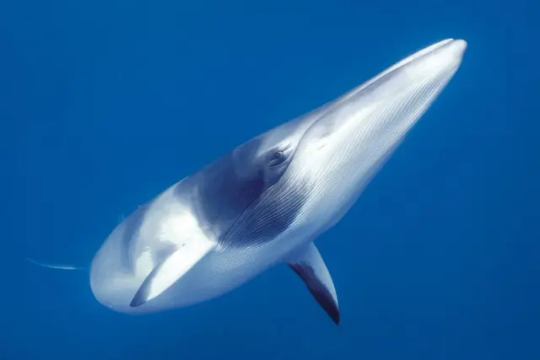
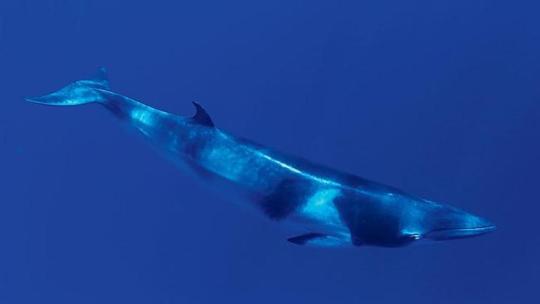
107 notes
·
View notes
Text
Why 23 Dead Whales Have Washed Up on the East Coast Since December#Dead #Whales #Washed #East #Coast #December
First a North Atlantic right whale, a critically endangered species, washed ashore in Virginia. Then a humpback floated onto a beach in New Jersey. Not long afterward, a minke whale, swept in on the morning tide, landed on the Rockaway Peninsula in New York City. And that was in just a single week this month. In all, 23 dead whales have washed ashore along the East Coast since early December,…

View On WordPress
0 notes